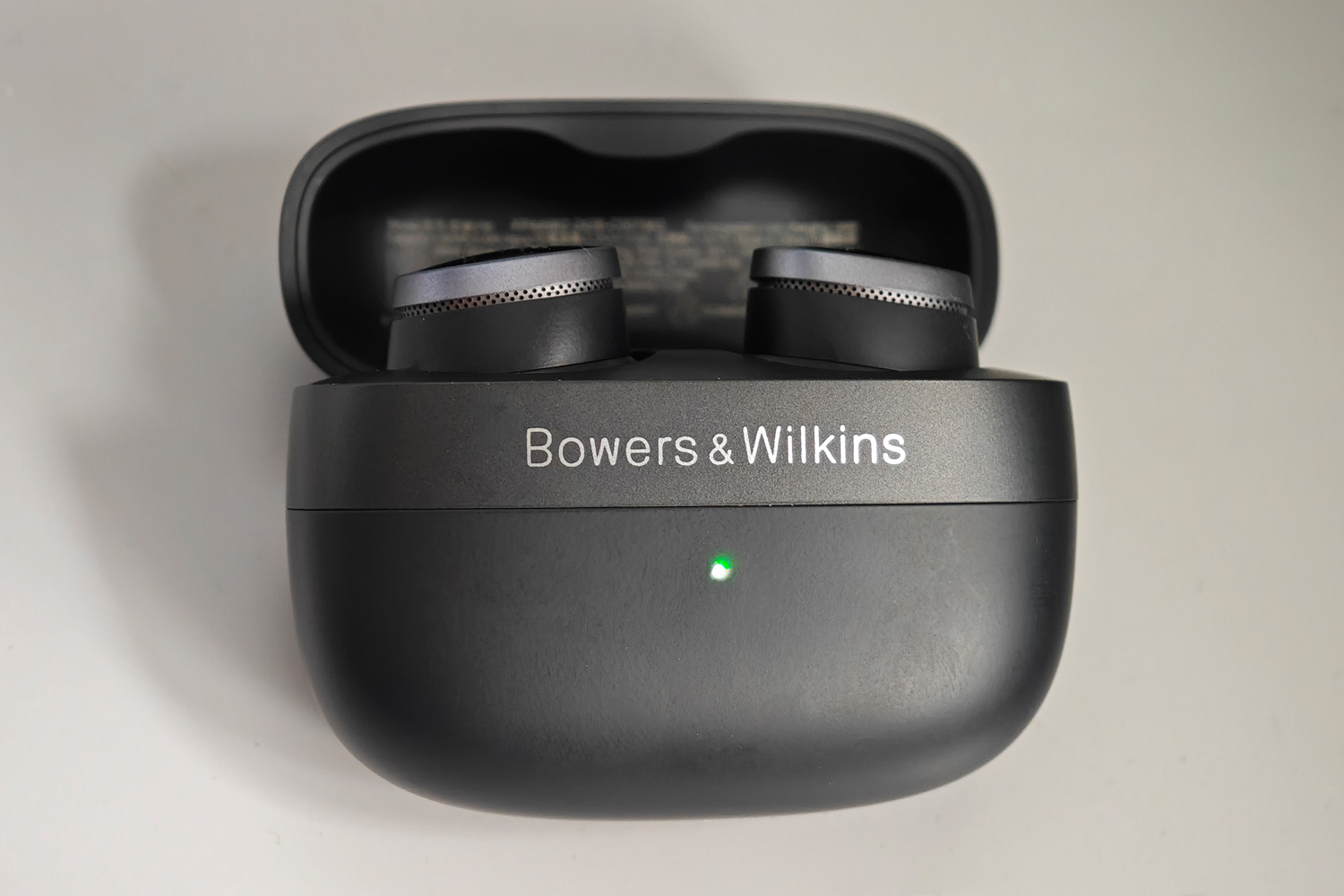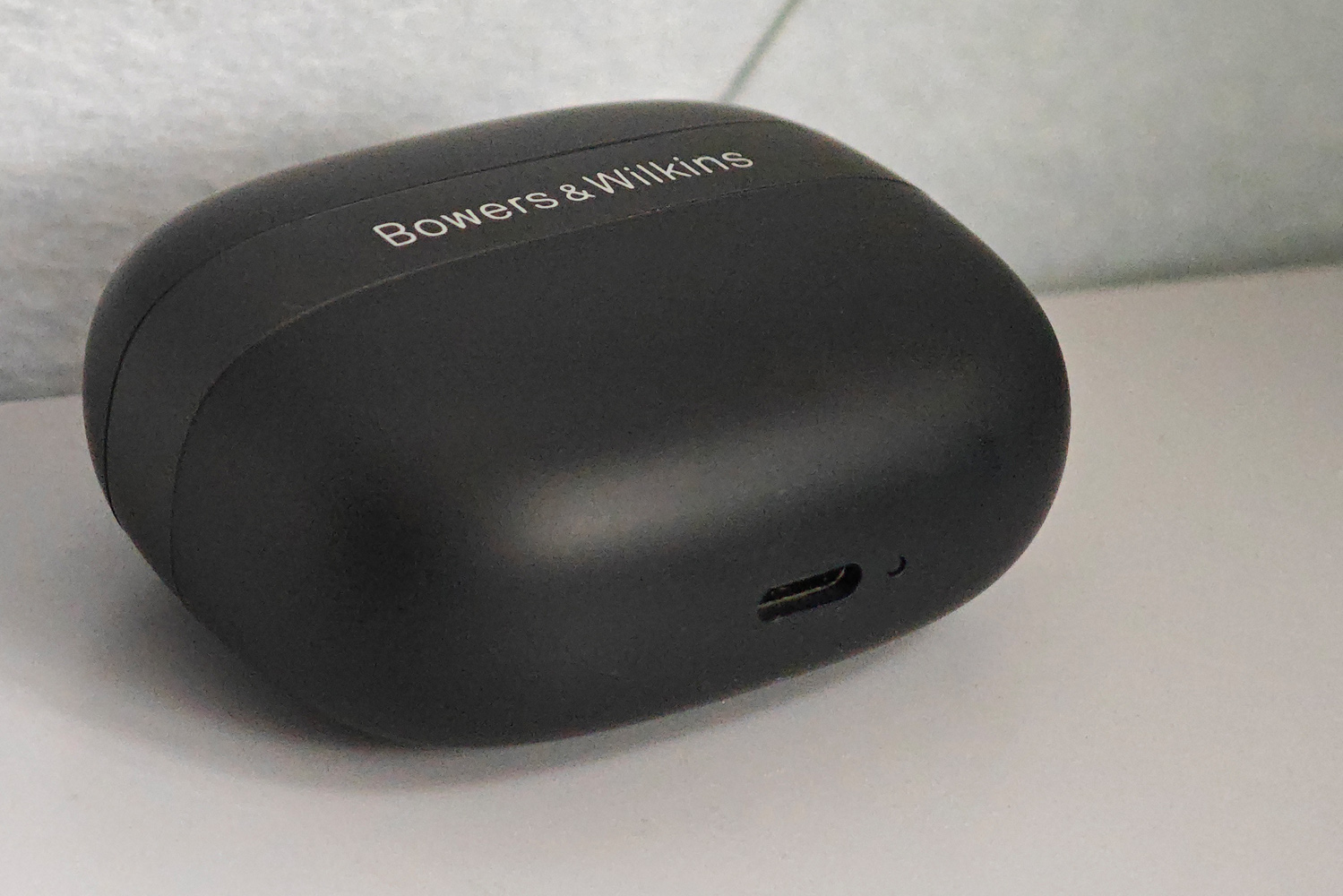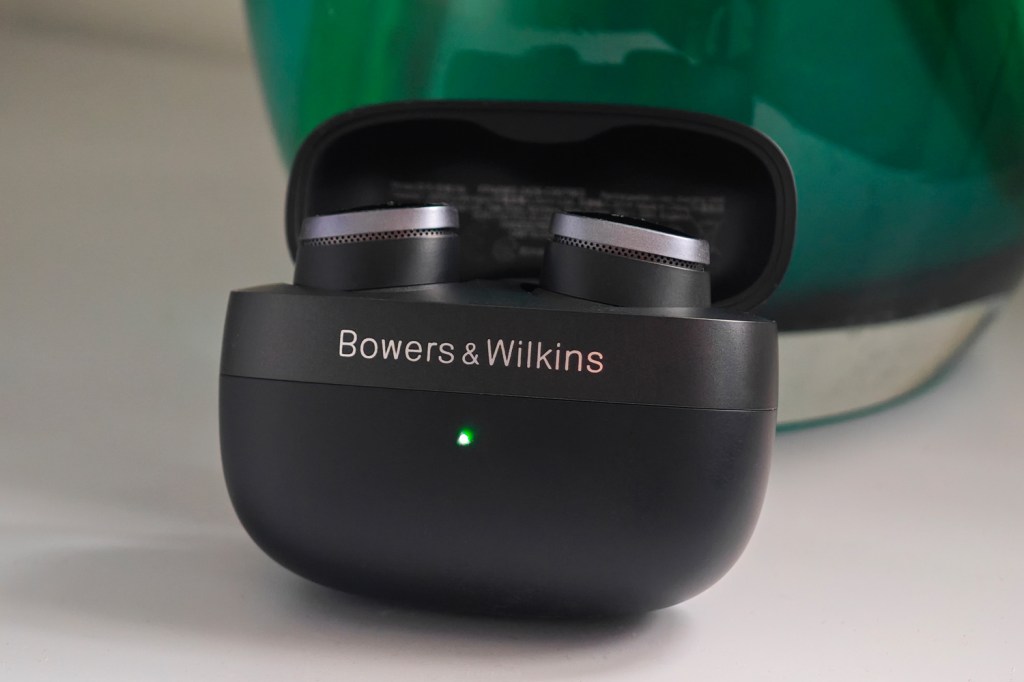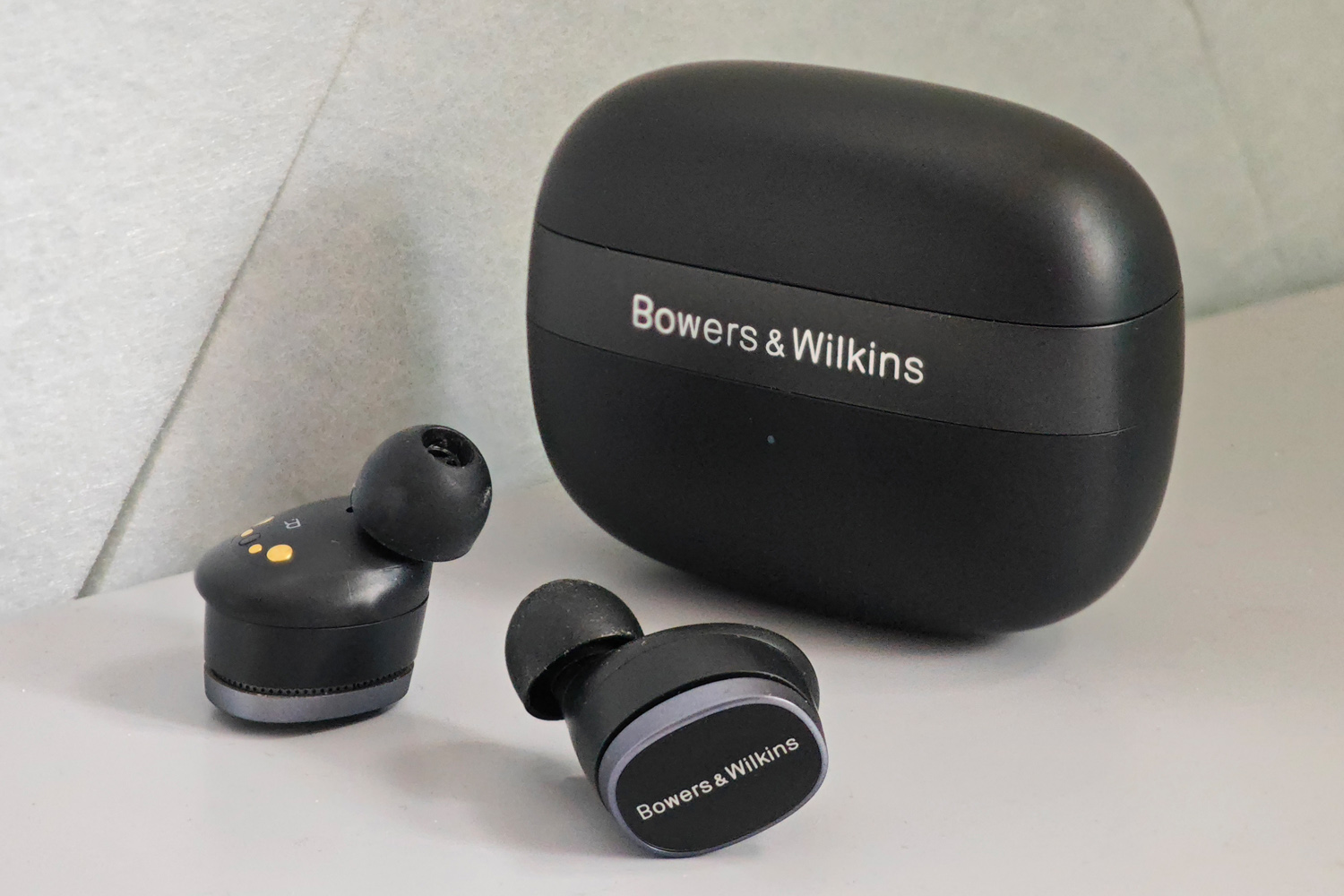Introduction
Bowers & Wilkins has a phenomenal track record when it comes to wireless earbuds, at least as far as sound quality goes. The firm hasn’t always hit a bullseye on comfort, though. It’s why the firm took advice from human body researchers for the new Pi8.
These top-tier in-ears are an evolution of the B&W Pi7 S2, debuting a thorough redesign meant to sit securely in a wider variety of ear shapes and sizes. It’s all change on the inside, too, ditching the dual driver setup for a single speaker using carbon cone tech first seen on the excellent PX8 over-ear headphones. The charging case has also been given lots of love, being far more pocket-friendly and gaining the ability to let connected devices stream in the highest possible quality Bluetooth codec.
Launching at £349, the Pi8 lands at the upper end of the true wireless spectrum. They’ll set you back more than either the Bose QuietComfort Ultra earbuds or Sony WF-1000XM5, which lead the class for noise cancelling. Can Bowers & Wilkins dethrone them with a focus on musicality?
Design & build: that shrinking feeling

The sculpted, streamlined Pi8 is a revelation compared to the angular Pi7. Each bud is a much simpler affair, with a one-piece design instead of the fussier two-part shape used before. The centre of gravity feels a bit more balanced as a result. A vented grille circles the entire outer section now, rather than just a small section, in order to boost Bluetooth signal strength and call quality from the built-in microphones. More on those later.
A new rubberised elastic piece around the inner part has a lot more give than the hard plastic on the old model, and adds a subtle wing tip that keeps the buds secured. These in-ears are much more comfortable to wear than the Pi7; I happily kept them in for entire working days without needing to take a break. They rarely shifted about while I was walking, and meant they didn’t need the constant micro-adjustment that rival pairs of in-ears did. Bowers also includes an XS silicone ear tip in the box now; previously you had to make do with small, medium and large sizes.
Bowers & Wilkins has properly embraced colour recently – just look at the Royal Burgundy PX8 and papaya orange Zeppelin. The Pi8 continues that trend, with four different hues from the off. Anthracite black and dove white are the safe bets, and Midnight Blue has proved popular elsewhere in the B&W range. Sage Green is the standout: the pastel shade and gold effect trim remind me of fancy Ladurée macarons. I do wonder whether Bowers could’ve used real aluminium trim, though.
Every version is IP54 splash resistant, and I was able to listen trouble-free when caught out by a surprise rain shower. They’ll cope just fine for sweaty gym sessions, too – though I doubt fitness fanatics are B&W’s biggest audience.
The charging case has been given a similarly dramatic makeover. It’s considerably smaller than the Pi7 S2’s, and the round, pebble-like shape is just plain nicer to hold than the old model’s angular flip-top. I’ve seen wireless earphones with even more compact cases, but had no trouble sliding this in and out of my jeans pockets. A metal hinge means it snaps shut with a more satisfying thunk, too.
Features & battery: a special case


Bowers & Wilkins was hardly going to skimp on hi-res audio support for the Pi8. It’s packing the latest-gen Qualcomm chipset, with aptX Adaptive tech for 24/96 playback. The redesigned antennae meant I had no issues with dropouts, even in congested areas like train stations.
There’s no LDAC, LC3 or Bluetooth LE on board – but you don’t necessarily need an aptX-ready device to stream in the best quality, a the charging case has a retransmit audio function. Connect it to your other gadget using the included USB-C or USB-to-3.5mm cables and it’ll instantly pick up the audio output, no touch gesture or in-app switching required. Latency wasn’t great when plugged into my Steam Deck over USB, so you’ll want to use the 3.5mm connection where possible for games and movies, but frequent travellers will love being able to hook into plane entertainment systems. Multipoint Bluetooth connectivity means you don’t need to rely on the case for the few gadgets you use on the daily, either.
The buds have a more conventional feature set. A wear sensor pauses your tunes when you pull one out of your ear, and wasn’t so sensitive it would trigger while I was walking around. The capacitive touch control surfaces are well judged, too, so I could adjust the fit without accidentally stopping playback. As usual, a single tap plays and pauses, double and triple taps skip forwards and backwards, and a tap-and-hold either toggles between ANC modes or wakes your phone’s voice assistant. There’s little in the way of customisation, though: just the option to change tap-and-hold to control volume instead.
Bowers & Wilkins aren’t interested in spatial sound just yet, citing concerns about head orientation not matching the placement of instruments. If you want 360-degree audio or Dolby Atmos playback you’ll have to look elsewhere.
I wouldn’t call the Bowers & Wilkins Pi8 an endurance champ, but it got very close to the firm’s battery life estimates in my testing. That meant ANC-on listening for a bit over six hours – an hour longer than the Pi7 S2 could manage. It’s now on par with the Apple AirPods Pro 2 and Bose QuietComfort Ultra Earbuds, but still an hour behind the Sony WF-1000XM5. A 15 minute trip to the charging case is good for another two hours of tunes though, so this is still a great choice for travel. The case holds another 13 or so hours, and can be topped up over USB-C or wirelessly on a Qi pad.
Interface: serene streaming
There are more reasons to download B&W Music than most earphone companion apps; it lets you quickly swap playback between the Pi8 and any other Bowers kit you own, and integrates streaming services such as Qobuz, Tidal, Deezer, TuneIn and Soundcloud. It’s a great way to amalgamate your various libraries and playlists without constantly swapping between streaming apps.
There’s not much in the way of customisation for the buds themselves, with just an option to toggle the wear sensor or pair a new device using Multipoint. Noise cancelling is just a basic toggle, with no way to adjust the level of passthrough.
The big new addition is a five-band equaliser, which is pretty much unheard of for a B&W product. Previous efforts just had bass and treble sliders, if there was any adjustment at all. There’s no way to save specific setups for certain genres, but an override toggle is a handy way of returning to the stock tuning without having to manually return all the sliders to zero.
Sound quality and noise cancelling: clarity king
With three microphones per bud and the same noise cancellation algorithms as the PX8 over-ears, the Pi8 does a great job of quietening the outside world without colouring the sound. It meant I could listen at a moderate volume without missing out on any fine details, even in fairly noisy environments. The tweaked fit and more sculpted shape means passive sound isolation is generally a step up from the Pi7 S2, too.
I still think Bose and Sony set the standard for silencing sudden shifts in background noise and higher frequency voice chatter, but the Pi8 still puts in a good showing. Low frequency public transport and the drone of air conditioning units are handled very well, too. Changing the placement of the mics has certainly made a difference for the better.
There’s also no doubt in my mind the Pi8 is a sonic step up from the Pi7 S2. It switches from dual drivers to a single 12mm dynamic unit, with the same sort of carbon cone as the PX8. The added stiffness reduces distortion at the upper end of the frequency range, which translates to simply brilliant levels of detail. With no driver crossover point to account for, everything flows beautifully together.
The precision and high frequency clarity on offer here make rivals seem almost muffled in comparison. Matt Bellamy’s falsetto vocals on Muse’s Panic Station have even more presence than usual. Softer acoustic tracks also really shine here. The soundstage might be tighter than a top-notch pair of over ear headphones, but music never felt compromisingly enclosed.
It feels like mid-range and top-end detail were the tuning priorities, but the Pi8 hasn’t skimped on bass. There’s plenty of low-end thump on electronic tracks, without encroaching on the rest of the frequency range. The pounding industrial synths on Health’s Stonefist are as uncompromising as intended, and nothing more. Meanwhile the Prodigy’s Ibiza is all unrelenting snares, aggressive guitar synths and a biting vocal courtesy of Sleaford Mods.
The buds aren’t short on amplification, either, with most of my listening done at 50% of my device volume.
Bowers & Wilkins Pi8 verdict


With absolutely stellar audio, the Bowers & Wilkins Pi8 truly deserves its spot at the top of the firm’s in-ear line-up. It has levelled up from the Pi7 S2 in all the right places, with a much improved fit, more consistent connectivity, and a more compact charge case that also brings clever rebroadcasting abilities.
It’s the carbon cone drivers that add a new level of sonic precision, so while Bose is still the noise cancelling king and Sony is the all-rounder pick, music lovers simply won’t care.
Bowers & Wilkins Pi8 technical specifications
| Drivers | 12mm dynamic, carbon cone |
| ANC | Yes |
| Bluetooth version | Bluetooth 5.4 |
| Codecs supported | aptX Lossless, AAC, SBC |
| Durability | IP54 |
| Battery life | 6.5hrs (buds) 13.5hrs (case) |
| Dimensions | 65x29x52mm, 46g (case) 7g (buds, each) |

